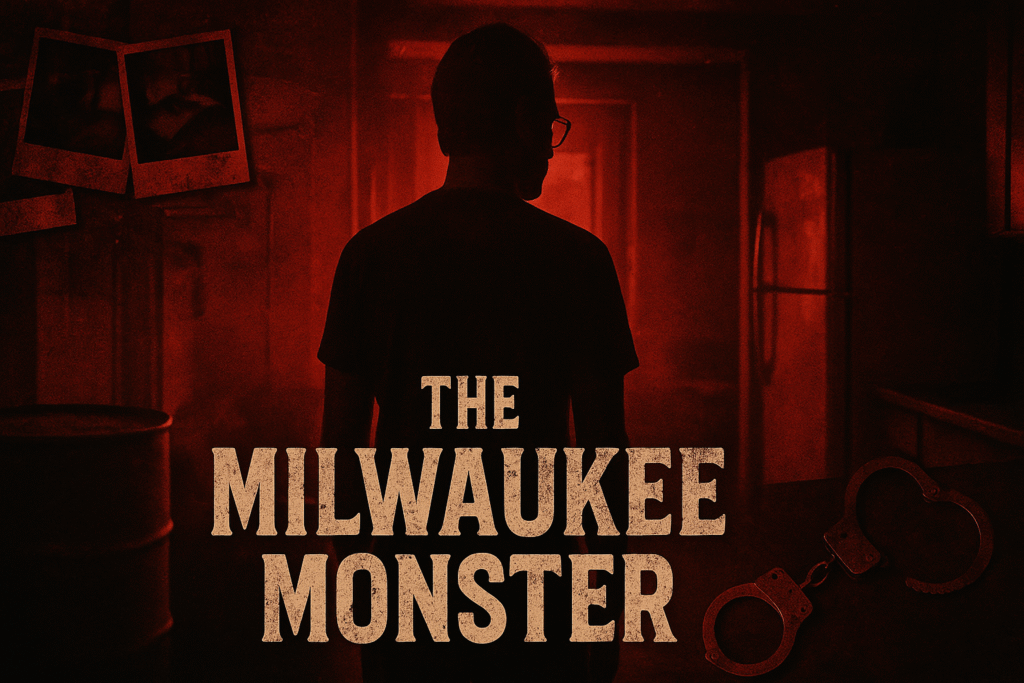In the dark archives of American crime, the name Jeffrey Dahmer strikes fear and morbid curiosity like few others. Known infamously as the “Milwaukee Cannibal” or the “Milwaukee Monster,” Dahmer committed some of the most shocking crimes in modern U.S. history. Between 1978 and 1991, he murdered 17 young men and boys, many of whom were sexually assaulted, dismembered, and even cannibalized.
This blog takes you on a chronological journey through Dahmer’s disturbing life, delving into his psychological profile, his chilling modus operandi, and the details of how he was finally caught.
😈 Name / Nickname
- Full Name: Jeffrey Lionel Dahmer
- Alias/Nicknames: The Milwaukee Monster, The Milwaukee Cannibal
Dahmer appeared to be an average, albeit quiet, boy from Milwaukee, Wisconsin. However, behind this unassuming exterior was a mind plagued by violent fantasies, loneliness, and a desperate need for control.
🧠 Psychological Profile
Jeffrey Dahmer’s mental landscape is one of the most studied among serial killers. Experts diagnosed him with multiple psychological disorders, including:
- Borderline Personality Disorder
- Schizotypal Personality Disorder
- Antisocial Personality Traits
Despite these conditions, court-appointed psychologists declared Dahmer legally sane during his trial. His murders were not spontaneous outbursts of rage; they were premeditated, methodical, and grotesquely intimate.
Childhood and Early Warning Signs
Dahmer showed early signs of emotional detachment and obsession with dead animals. As a child, he collected roadkill and dissolved animal remains in acid. His parents’ turbulent marriage and eventual divorce deepened his psychological isolation.
His drinking problem began in high school. By the time he committed his first murder at 18, Dahmer was already battling intense sexual fantasies involving control, death, and submission.
The Fantasy of Control
Dahmer’s driving force was not sadism alone—it was control. He wanted his victims to stay with him, to be compliant, even in death. This desire led him to perform amateur lobotomies and chemical injections in victims’ brains, hoping to create sex zombies.
His necrophilic tendencies reveal another layer of his psyche: for Dahmer, death was not an end but a way to eternalize companionship.
📍 Victim Count & Timeline

Between 1978 and 1991, Jeffrey Dahmer brutally murdered 17 young men and boys. The pattern of his killings reveals a chilling evolution—from impulsive beginnings to calculated, ritualistic murders.
🩸 The First Kill – 1978
Dahmer’s killing spree began shortly after high school. On June 18, 1978, he picked up 18-year-old Steven Hicks, brought him home for drinks, and killed him with a dumbbell when Hicks tried to leave. Dahmer dismembered the body and scattered the remains in the woods. This first murder haunted him for nearly a decade.
🛑 The Dormant Years – 1978–1987
A long gap followed as Dahmer struggled with alcoholism and suppressing his violent urges. He briefly joined the army and lived in Miami and Ohio. But the fantasies didn’t go away. By late 1987, he gave in again.
🔥 Escalation – 1987–1991
From 1987 onward, Dahmer’s murders became more frequent and methodical. He killed in Milwaukee, using his apartment as a killing ground. He photographed victims, kept trophies, and experimented with preserving body parts.
Here’s a detailed timeline:
| Date | Victim | Age |
|---|---|---|
| June 18, 1978 | Steven Hicks | 18 |
| November 20, 1987 | Steven Tuomi | 25 |
| January 16, 1988 | James Doxtator | 14 |
| March 24, 1988 | Richard Guerrero | 22 |
| March 25, 1989 | Anthony Sears | 24 |
| May 20, 1990 | Raymond Smith | 32 |
| June 1990 | Edward Smith | 27 |
| September 1990 | Ernest Miller | 22 |
| September 24, 1990 | David Thomas | 23 |
| February 18, 1991 | Curtis Straughter | 17 |
| April 7, 1991 | Errol Lindsey | 19 |
| May 24, 1991 | Tony Hughes | 31 |
| May 27, 1991 | Konerak Sinthasomphone | 14 |
| June 30, 1991 | Matt Turner | 20 |
| July 5, 1991 | Jeremiah Weinberger | 23 |
| July 15, 1991 | Oliver Lacy | 23 |
| July 19, 1991 | Joseph Bradehoft | 25 |
⚠️ Key Patterns
-
Dahmer’s killings displayed distinct behavioral and psychological patterns:
- Victim Profile: Nearly all victims were young, attractive men; many were people of color and from marginalized communities. Several were underage.
- Location Consistency: Most murders occurred in Dahmer’s apartment, making it a controlled environment where he could take his time.
- Luring Technique: He frequently used offers of money, alcohol, or photography gigs to lure victims.
- Ritualistic Behavior: Dahmer followed a gruesome ritual that included drugging, strangulation, necrophilia, dismemberment, and preservation of body parts.
- Escalation in Frequency: 1991 saw a terrifying spike—six victims killed in July alone. His need for control and companionship grew insatiable.
- Trophies and Mementos: Dahmer kept skulls, genitals, and even hearts in freezers. These trophies provided a twisted sense of companionship.
- Photographic Evidence: He photographed victims in various stages of death and dismemberment, using these images for later gratification.
- Medical Experiments: He attempted lobotomies and brain injections to create submissive, undead companions—a macabre blend of science fiction and pathology.
Together, these patterns show that Dahmer was not a disorganized killer acting on impulse; rather, he was methodical, calculated, and terrifyingly deliberate.
🧪 Signature / MO (Modus Operandi)

Jeffrey Dahmer’s modus operandi is among the most chilling and ritualistic in the annals of serial homicide. His pattern of killing was not just about murder—it was about domination, control, and possession that extended beyond death. His methods evolved over time, growing increasingly grotesque as he experimented with ways to keep his victims near him forever.
1. Victim Selection and Luring
Dahmer primarily targeted young men, often marginalized by society—Black, Latino, Asian, or LGBTQ+ individuals. He frequented gay bars, malls, and bus stops to find vulnerable individuals who wouldn’t be missed right away. His common approach was offering money in exchange for nude modeling, drinks, or companionship.
2. Isolation and Drugging
Once in his apartment, Dahmer would offer his victim a drink laced with sleeping pills or sedatives—most commonly triazolam or temazepam. Within minutes, the victim would lose consciousness. This allowed Dahmer complete control, initiating the next phase of his ritual.
3. Murder Methods
The majority of his victims were strangled to death after being drugged. The act of strangulation allowed Dahmer to be physically close, reinforcing his obsessive need for control and intimacy. Occasionally, he would use blunt force trauma.
4. Sexual Acts and Necrophilia
Dahmer frequently engaged in necrophilic acts with the corpses. For him, a dead body was ideal—unresisting, present, and eternally silent. He later admitted this was the only way he could feel a lasting connection with someone.
5. Dismemberment and Trophy Keeping
After the murders, Dahmer dismembered the bodies in his bathtub or kitchen. He boiled body parts in industrial-grade chemicals and bleach to strip flesh from bone. Many bones were kept, cleaned, and displayed. He kept skulls, genitalia, and internal organs as trophies. The refrigerator in his apartment contained severed heads, hearts, and even a complete human torso at times.
6. Photographs and Documentation
Before and after dismemberment, Dahmer would photograph his victims in posed and often sexually suggestive positions. These Polaroids served as a visual library to relive the murders.
7. Cannibalism
In his later killings, Dahmer began eating parts of his victims—especially biceps, thighs, and hearts. This was, in his words, an attempt to make them “a part of him forever.” Cannibalism offered a symbolic and literal consumption of his need for eternal control.
8. Preservation Attempts
Dahmer attempted to preserve some bodies using formaldehyde, acetone, and freezing methods. He wanted to create an obedient companion, suspended in a near-death state. His most disturbing experiment was injecting hydrochloric acid or boiling water into the brains of living victims in an attempt to zombify them.
9. Apartment as a Kill Zone
Apartment 213 at the Oxford Apartments became his private chamber of horrors. With its locked doors, covered windows, and the absence of frequent visitors, it was the perfect setting for his systematic approach to murder.
Summary of MO Components:
- Lure: Promise of money or companionship
- Sedation: Drugged beverages
- Murder Method: Strangulation or blunt force
- Post-Mortem: Necrophilia, dismemberment, preservation
- Documentation: Polaroid photography
- Trophies: Skulls, organs, bones
- Cannibalism: Symbolic possession of victims
Dahmer’s signature wasn’t just physical; it was psychological. His MO reflects his yearning to control every aspect of a relationship—even if it meant destroying a life to preserve it.
🚓How Did He Get Caught
Dahmer’s arrest on July 22, 1991, marked the end of one of the most terrifying killing sprees in U.S. history. But unlike many serial killers who are caught through investigative breakthroughs or years of profiling, Dahmer’s downfall came from the survival and bravery of a potential victim.
The Escape
On that day, Dahmer approached Tracy Edwards, a 32-year-old man, at a shopping mall and offered him $100 to pose for photos at his apartment. Edwards accepted. Once inside, he noticed the foul smell, barrels, and disturbing atmosphere. Dahmer handcuffed him and threatened him with a knife.
Instead of panicking, Edwards stayed calm and waited for an opportunity. After hours of gaining Dahmer’s trust and talking him down, Edwards managed to punch Dahmer and flee the apartment. He ran into police officers and immediately led them back to Dahmer’s residence.
The Shocking Discovery
What Milwaukee police found inside Apartment 213 was beyond comprehension:
- Polaroid photos of dismembered bodies in various stages
- Human skulls and bones throughout the apartment
- A 57-gallon drum filled with decomposing body parts
- Severed heads in the refrigerator and freezer
- A human heart and other organs preserved for later consumption
The photos confirmed that the horrors were not fantasy—they were fact. The scene was so shocking that many officers required therapy afterward.
Confession and Aftermath
Dahmer confessed in chilling detail to all 17 murders. He described the methods, the victims, and even the feelings he experienced during each act. His calm demeanor during confession only amplified the horror.
He was charged with 15 counts of first-degree murder in Milwaukee and later confessed to two additional killings in Ohio.
His arrest marked not just the end of his spree, but the beginning of a long legal and societal reflection on how he remained undetected for so long.
Trial and Imprisonment
Jeffrey Dahmer’s trial began in January 1992. He pleaded guilty but insane to 15 counts of murder. Despite his legal team’s insanity defense, the jury found him legally sane and sentenced him to 15 consecutive life sentences, totaling 957 years.
On November 28, 1994, Dahmer was beaten to death by a fellow inmate, Christopher Scarver, inside Columbia Correctional Institution. His death, like his life, stirred complex public reactions—relief, horror, and intrigue.
📚 Books and 🎥 Documentaries Available
Books:
- A Father’s Story by Lionel Dahmer (Jeffrey’s father)
- The Shrine of Jeffrey Dahmer by Brian Masters
- Jeffrey Dahmer: A Terrifying True Story by Jack Rosewood
Documentaries and Shows:
- Dahmer – Monster: The Jeffrey Dahmer Story (Netflix, 2022)
- Conversations with a Killer: The Jeffrey Dahmer Tapes (Netflix)
- The Jeffrey Dahmer Files (IFC Films)
These explore not just the crimes but the social failings—racism, homophobia, and policing gaps—that allowed Dahmer to go unnoticed for so long.
Conclusion
Jeffrey Dahmer’s story is not just one of horror—it’s also a mirror reflecting deep flaws in our society’s treatment of mental health, policing, and marginalized communities. His case continues to captivate and repulse, reminding us of the thin line between normalcy and nightmare.
By understanding the full scope of Dahmer’s crimes, we don’t just indulge in morbid curiosity—we also remember the victims, the warning signs missed, and the lessons that must never be forgotten.



Sweet blog! I found it while surfing aroun on Yaahoo News.
Do you have any tips on how to get liisted in Yahoo News?
I’ve been trying for a while but I never seem to get there!
Cheers http://boyarka-Inform.com/